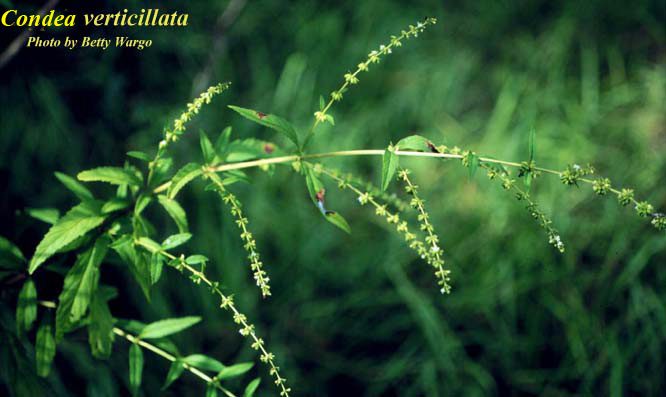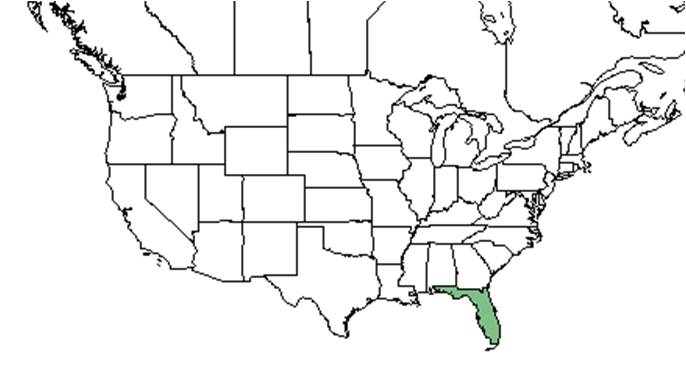Condea verticillata
| Condea verticillata | |
|---|---|

| |
| Photo by Betty Wargo, Atlas of Florida Vascular Plants | |
| Scientific classification | |
| Kingdom: | Plantae |
| Division: | Magnoliophyta - Flowering plants |
| Class: | Magnoliopsida - Dicotyledons |
| Order: | Lamiales |
| Family: | Lamiaceae ⁄ Labiatae |
| Genus: | Condea |
| Species: | C. verticillata |
| Binomial name | |
| Condea verticillata Jacq. | |

| |
| Natural range of Condea verticillata from USDA NRCS Plants Database. | |
Common name: John Charles
Contents
Taxonomic notes
Synonym: Hyptis verticillata Jacquin.[1]
Varieties: none.[1]
Description
Distribution
Ecology
Habitat
C. verticillata has been found in secondary oak-hickory-magnolia wood habitat, evergreen tropical forests, and mesic woods.[2][3] It is also found in disturbed areas including along roadsides, evergreen tropical forests disturbed by coffee cultivation, and canal banks.[4][2][5]
Associated species include Chamaesyce hyssopifolia and Saurauia sp.[4][2]
Phenology
Has been seen flowering in September.[4]
Pollination and use by animals
Various pollinator species were observed to visit flowers of Condea verticillata at the Archbold Biological Station. These species include bees from the Apidae family (Apis mellifera and Bombus impatiens), plasterter bees from the Colletidae family (Colletes mandibularis and C. thysanellae), sweat bees from the Halictidae family (Augochlora pura, Augochlorella aurata, Augochloropsis metallica and Lasioglossum pectoralis), wasps from the Leucospididae family (Leucospis robertsoni and L. slossonae), leafcutting bees from the Megachilidae family (Coelioxys dolichos and Heriades leavitti), spider wasps from the Pompilidae family (Episyron conterminus posterus), thread-waisted wasps from the Sphecidae family (Anacrabro ocellatus, Bicyrtes quadrifasciata, Philanthus ventilabris and Prionyx thomae), and wasps from the Vespidae family (Pachodynerus erynnis, P. nasidens and Vespula squamosa).[6]
Conservation, cultivation, and restoration
Cultural use
Photo Gallery
References and notes
- ↑ 1.0 1.1 Weakley, A.S. 2015. Flora of the southern and mid-atlantic states. Working Draft of 21 May 2015. University of North Carolina at Chapel Hill, Chapel Hill, North Carolina.
- ↑ 2.0 2.1 2.2 Herbario del Jardín Botánico BUAP accessed using Southeastern Regional Network of Expertise and Collections (SERNEC) data portal. URL: http://sernecportal.org/portal/collections/index.php Last accessed: May 2021. Collectors: Jonathan D. Amith, Pantepec. Countries and Municipalities: Mexico: Coahuitlán, Pantepec, Puebla, and Veracruz.
- ↑ University of Kansas Ronald L. McGregor Herbarium accessed using Southeastern Regional Network of Expertise and Collections (SERNEC) data portal. URL: http://sernecportal.org/portal/collections/index.php Last accessed: May 2021. Collectors: R P Wunderlin, Anthony N Arcuri, and B Hansen. States and Counties: Florida: De Soto and Arcadia.
- ↑ 4.0 4.1 4.2 Florida State University Robert K. Godfrey Herbarium database. URL: http://herbarium.bio.fsu.edu. Last accessed: May 2021. Collectors: James R. Burkhalter, James D. Ray, Jr. States and counties: Florida: Bay and Hernando.
- ↑ University of South Florida Herbarium accessed using Southeastern Regional Network of Expertise and Collections (SERNEC) data portal. URL: http://sernecportal.org/portal/collections/index.php Last accessed: May 2021. Collectors: B. F. Hansen and J. Hansen. States and Counties: Florida: Broward.
- ↑ Deyrup, M.A. and N.D. 2015. Database of observations of Hymenoptera visitations to flowers of plants on Archbold Biological Station, Florida, USA.